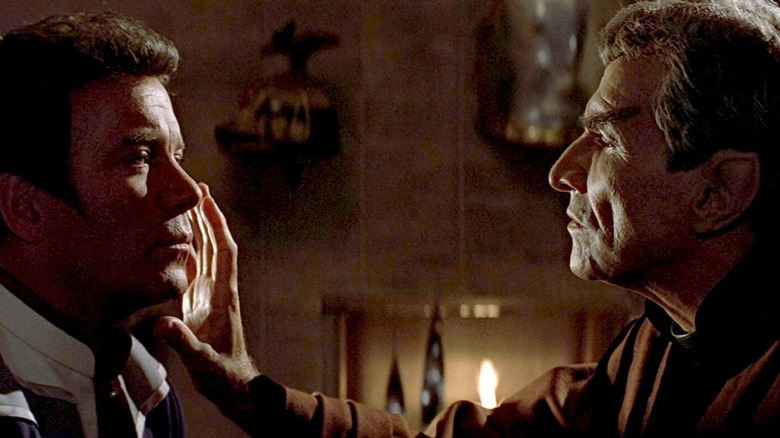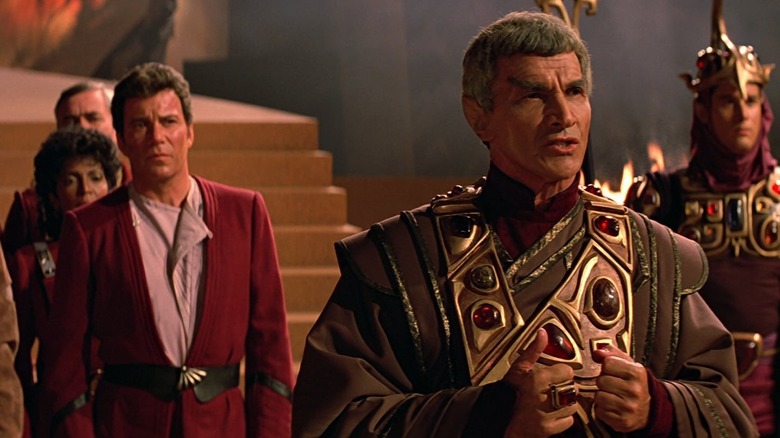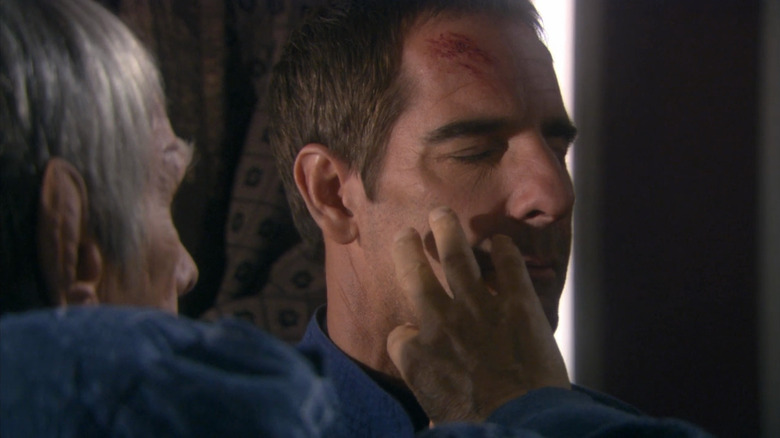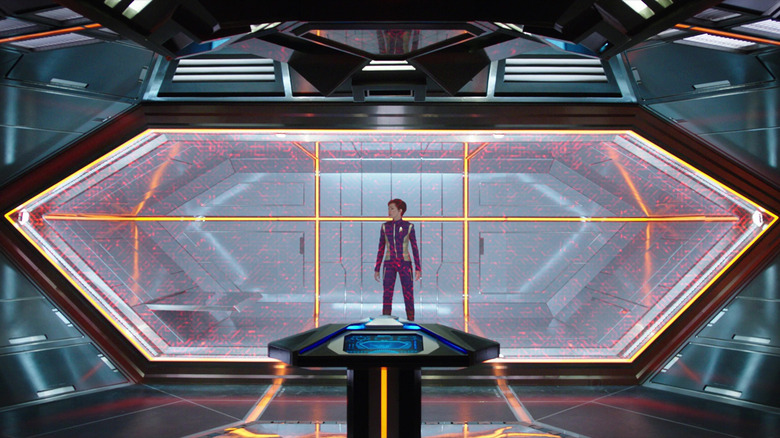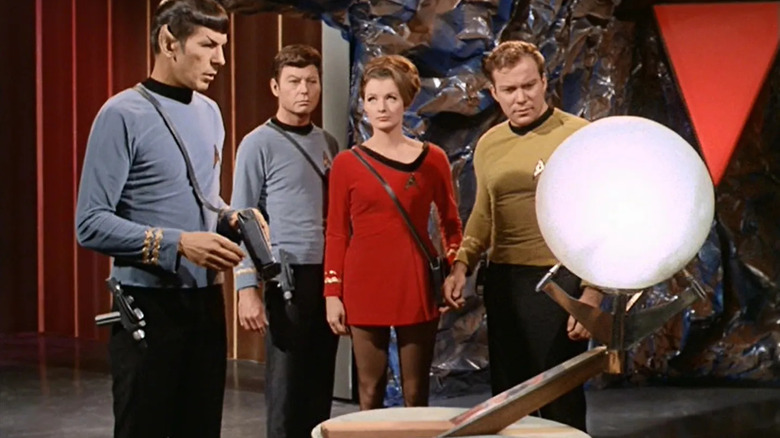My Mind To Your Mind: Vulcan Katras Explained
When "Star Trek" first debuted in 1966, the standout character was very much Spock (Leonard Nimoy) the half-human, half-Vulcan science officer on board the U.S.S. Enterprise. Spock, for the uninitiated, devoted himself to the expulsion of emotion from his being, relying on only logic and scientific proof to traverse the show's weekly conundra. Over the course of various "Star Trek" shows and movies, the specific abilities and beliefs of Vulcans were revealed: Vulcans are incredibly long-lived. Vulcans have green blood. Vulcans are much stronger than humans. Vulcans are trained to, in a pinch (heh), tightly squeeze a nerve on the humanoid neck to render them unconscious. Vulcans are typically vegetarians. Vulcans go through a seven-year mating cycle called pon farr, wherein they become uncontrollably horny for a few days.
Most fascinating — to use a Spock word — is the Vulcans' ability to meld minds with others. Vulcans have been described as "touch telepaths," and have the gentle psychic ability to place their hands on a willing recipient's face and merge their consciousnesses, allowing each to briefly live inside one another's minds.
Psychic abilities have been common in "Star Trek" since the start; the pilot episode "Where No Man Has Gone Before" revealed that Starfleet officers, regardless of species, are given a psychic-powers test upon enrollment, and many come up with positive numbers (the Sally Kellerman character is a human who could intuit minds). In the world of "Star Trek," then, consciousness is something widely accepted as existing outside of the brain. And, we learn, it can be shunted into a waiting recipient.
This is an important plot point in this week's episode of "Star Trek: Strange New Worlds" which hearkens back to "Star Trek III: The Search for Spock."
The Vulcan katra in 'Star Trek III'
Leonard Nimoy's "Star Trek III: The Search for Spock" (1984) picks up immediately after the events of "Star Trek II: The Wrath of Khan." A damaged U.S.S. Enterprise returns to a Starbase for repair, with Spock having died during the previous film's climax. Curiously, Dr. McCoy (DeForest Kelley) begins behaving quite oddly, speaking in Spock's voice, taking on some of his personality traits (this is played for laughs; Spock and McCoy were famously rivals), and trying to book a surreptitious flight back to where Spock's body landed. Spock's father, Sarek (Mark Lenard) suspects something is amiss and performs a mind meld on Kirk (William Shatner) only to find that he is not carrying his son's "katra." Kirk is unfamiliar with the term, and Sarek explains that it — more or less — is the measurable, palpable version of the soul. Kirk, upon watching a scene from "Star Trek II" (he conveniently has the previous film at hand), finds that Spock mind-melded with McCoy shortly before his death. Spock's katra, his consciousness, is now in McCoy's brain.
Spock's consciousness can indeed be reunited with his body and, thanks to the effects of "Star Trek II"'s Genesis wave, a new Spock body may soon be handy (the wave creates life, and grows a living Spock body without a mind). "Star Trek III" is about how Kirk and the Enterprise crew have to steal their ship (!) and perform a ritual on Vulcan that would reunite mind and body. What they lose in order to do so is immeasurable. "Star Trek III" has a great bummer ending.
Surak's katra
In "Star Trek" chronology, the first instance of humanity encountering a katra was in a three-part episode of "Star Trek: Enterprise" called "The Forge," "Awakening," and "Kir'Shara" (aired on November 19 through December 3rd, 2004). These episodes took place at a time in Trek history when Vulcan mind melds were illegal, and those with the ability are seen as outcasts. It's a clear metaphor for queerness and the bigotry directed against it. There is an additional metaphor for Reagan's treatment of the AIDS pandemic in the 1980s with the introduction of Pa'Nar Syndrome — a mind-meld-caused illness — and the Vulcan High Command's unwillingness to address or treat it.
In the three-parter, Capt. Archer (Scott Bakula) encountered a Vulcan dissident named Syrran (Michael Nouri) who was carrying the katra of Surak, an ancient Vulcan Messiah. Jonathan Archer agreed to carry the katra of Surak in his brain for four days while the Enterprise made their way to another Vulcan priest to whom it could be transferred again. It was the events of these episodes that, it was implied, would lead to more cavalier attitudes about mind melds in "Star Trek" moving forward.
Spock's katra in Burham's brain
"Star Trek: Discovery" has notoriously played fast and loose with "Star Trek" canon, rewriting rules, shifting technologies (person-to-person holograms were on the U.S.S. Discovery, but still not perfected a century later on "Deep Space Nine"?), and introducing new, dramatic backstories to characters previously established. The character of Michael Burnham (Sonequa Martin-Green), the protagonist of "Discovery" was, in fact, a never-mentioned-before sister of Spock (now played by Ethan Peck) who was raised on Vulcan under Vulcan logical doctrines. Early in "Discovery" — the second episode "The Battle at the Binary Stars" from September 24, 2017 — she reveals that, as a child, she had nearly died and Spock, acting fast, inserted a mere portion of his katra into her brain, saving her life.
Like most things in "Discovery," the full implications of this are never really explored, other than to say that Burnham and Spock are especially close in an abstract sort of way. It hasn't been brought up since the second episode either, and that version of Spock has since twisted off to become a central character in "Star Trek: Strange New Worlds." Conveniently, a massive, season-end plot twist required any and all mention of the U.S.S. Discovery to be stricken from Starfleet history, and saw the ship thrown nearly a millennium into the future, allowing all of the show's reckless handling of canon to essentially be undone.
'Return to Tomorrow'
The first mention of a Vulcan katra to have aired on TV is probably in the original series episode "Return to Tomorrow" (February 9, 1968). In that episode, a trio of noncorporeal entities named Thalassa, Sargon, and Henoch, attempt to take over the bodies of Kirk and company. The three of them have a centuries-old beef, leading, naturally, to intrigue. Fascinatingly, the Enterprise crew suggests the invasive alien consciousnesses be shunted into android bodies. By the end of the episode, it looks as if Spock has been murdered — the machine said to contain his consciousness is smashed — but, cleverly, Spock was able to shunt his own mind over into the brain of Nurse Chapel (Majel Barrett).
The word "katra" is not used in "Return to Tomorrow" to the author's recollection, but it certainly set a precedent for Vulcan minds in the future. One can, with a small amount of effort, store your brain in the body of another. There has not been an episode to date about an ancient Vulcan who has malevolently elected to remain alive for millennia by usurping host bodies, although "Star Trek" continues, and such a story could conceivably be written.
'Spock Amok'
In this week's episode of "Strange New Worlds," the katra returns, but this time to comedic effect. Spock and his intended T'Pring (Gia Sandhu) have gathered in private for a bout of Vulcan intimacy when a psychic mishap has the two of them accidentally inhabiting one another's bodies. There's a definite comfort about "Star Trek" returning to an episode-by-episode structure — as "Strange New Worlds" has eschewed longer arcs for single episodes — as now there can be "funny ones" again. Spock, the ultimate straight man, has to attend to T'Pring's meetings in her body, while T'Pring must attend diplomatic meetings with little experience in the process. It's a wonderful acting showcase episode, and elicits plenty of titters.
Given that the shunting of Vulcan katras has now been the set piece of one Trek feature film, has been used as a clever/cheap circumvention of danger more than once, and has now been used as comedic screenwriting fodder, perhaps the conceit will remain a mere background detail. The easy swapping of bodies can too easily fall into the realm of contrivance, and make for a lack of drama (the same way transporters can be used to cure any disease or restore a person to an earlier version of themselves, potentially allowing them to live forever). "Strange New Worlds" not only poked fun at the idea, but also indicated that katra swapping can occur too easily, and that katras should, perhaps, not be monkeyed with.
